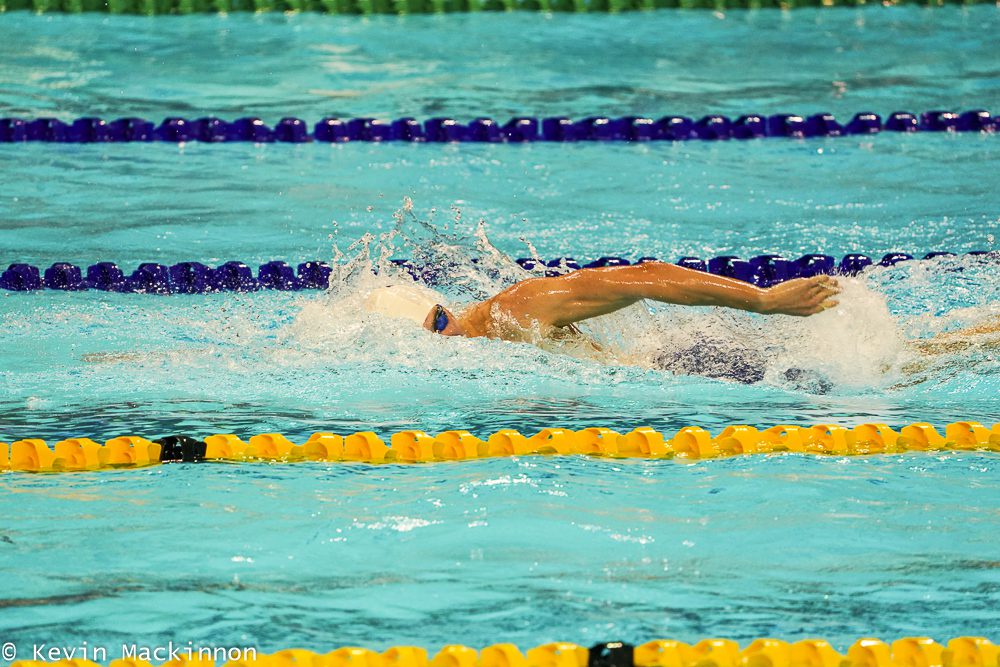Swim sessions: What’s the Frequency?
When it comes to improving your swimming, getting in the water more often probably helps more than swimming longer.

There are many factors to consider, but coaches I’ve worked with in the past were of one mind: frequency of touch outweighs the length of touch. That is to say, swim more often, rather than swim longer. My own experience has only served to reinforce that belief.
By Clint Lien
Let’s face it, swimming is the neon-hued sheep of triathlon. There are technical elements involved in running and biking faster, but not to the level of swimming. You can increase your swimming from three hours to nine hours a week and barely gain two seconds per hundred if you’re just getting in there and hammering away. (But you’ll be able to hold those hundreds for longer and feel better when you’re done.) Increase your running or biking by the same and, provided you don’t get injured or burned out, you’ll go faster.
So the question is: if you’re willing to swim more in order to improve your swim times, how best to implement that?
Training can be boiled down to three simple elements: intensity, duration, and frequency. There’s an almost infinite number of ways to measure each of these, and just as many companies trying to sell you the latest device to quantify them. But it’s hard to go wrong with a watch, a logbook and some honest self reflection.
Adding intensity to your swimming is a bit of subjective thing. You can take less rest and add repeats to your sets, but there’s a trade off there that doesn’t necessarily result in increased intensity. Anyone who’s executed 6 x 50 all out with two minutes rest knows what I’m talking about.
Adding intensity is a complex endeavour and can be difficult to measure. Start by agreeing (with yourself and/or your coach) that you will try to work the hard sets harder and the easy ones easier. For most, this will result in an overall increase in intensity levels that can produce satisfying results.
Another way to increase your swimming is to increase the duration of each of your swims. A common push-back I get on this is “The session goes for an hour. There’s nothing I can do about that.” That’s hogwash. By being the first in the water and the last out, most swimmers would add about 10 percent to their swim time. It happens, but it’s a rare pool that wouldn’t allow a swimmer to get in a bit early or remain in the pool after and get in another 15 minutes beyond the scheduled club session.
If you’re swimming on your own, then adding time to each swim shouldn’t be an issue. Start by adding 10 percent more time a week until you’ve added an additional hour to your swim week.
It’s not uncommon for a triathlete’s swim program to consist of three swims a week, and all three of them will include some (or a lot) high intensity efforts. Contrast that to almost every athlete’s bike and run programs, which traditionally have a few easy workouts. So, by acknowledging this most obvious difference, we also come to the best answer to our initial question. Add an “easy” swim to your program – increase your frequency. I call these “permission” swims. This is where you give yourself all kinds of permissions – you might get in late, get out early, wear your “cheater” pants, etc.
The point is to get in the water for an extra session and focus on feeling good in the water – focus on your form. The effects of this extra session can be profound. One of the most frequent feedback I get from athletes who do this is that they really look forward to that swim and they feel better during their other regularly scheduled sessions. An extra hour of swimming a week where you are focusing on body position and stroke improvement can really make a difference.
Here’s an on your own easy set where form is the focus and there’s not a tough stroke included:
2 times through:
- 200 easy choice
- 200 pull-snorkel – focus on the long tight body, high elbows and initiating your catch quickly
- 200 kick no board with fins – Shallow kick for good body position over propulsion.
- 4 x 50 with ankle band. If you’re really dragging the pool, then start with some paddles to help until you start to “get it.”
- 3 x 200 pull/paddles – small or med size with 20 SRI (Seconds Rest Interval). Feel the water.
- 200 pull-snorkel
The total session is 2,400 meters and you’ll be a better swimmer for it.

So if you want to “increase” your swimming, you can work harder during your swims. You can make your swims longer and/or you can add additional swims to your program. Where possible, go with the latter and, rather than just hammer out another hour or two, focus on form.
And to that original swimmer – I suppose, if I had my druthers, I’d see her do two sessions of 90 minutes and three sessions of one hour because she’s training for an Ironman. But that’s another article. The world is not black and white.
Clint Lien is the head coach of Victoria’s Mercury Rising Triathlon www.mercuryrisingtriathlon.com
This story originally appeared in the January, 2020 issue of Triathlon Magazine Canada.
